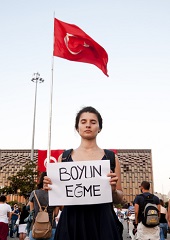What Unites Turkey’s and Iran’s Youth
How are the young reformers in Turkey and Iran united by their actions in June 2013? What does their future path look like?
July 2, 2013

For all the attention that has been paid to parallels between the street protests in Turkey and Brazil, the even more intriguing comparison concerns Turkey and Iran.
Focusing on young people, we see six dimensions that are critical to understand for the global public.
1. Above and beyond the Arab Spring
Turkish and Iranian youth made history in June 2013, using starkly different forms of collective action.
The events in Iran and Turkey reveal a different breed of young people.
And they point to political and social activism that stands apart from the youth movement that led to the Arab Spring in 2011.
The Arab Spring replaced old authoritarian regimes with new, and mostly religious, governments that conceptualize democracy as pure majoritarianism, without any concessions to pluralism.
The youth in Iran and Turkey promise an outcome that is potentially far more democratic, peaceful, inclusive and inspiring. Their movement is antiauthoritarian, modern and secular.
2. Turkey
A protest that began with a simple and manageable demand to save a green space in the center of Istanbul, peculiarly at the Turkish Prime Minister’s own choosing, careened out of control — and turned into an unprecedented political crisis.
The protests brought together a remarkable coalition of young Turks in defiance of the gross violence of the police.
It politicized those who had stayed on the margins of politics and activism. It awakened a dormant longing for pluralism and anti-authoritarianism.
The ill-tempered reaction by the Turkish government to the youth protests transformed Turkey. True, the movement has quieted down for now. The state will most likely win this stage of the confrontation.
However, what occurred brought the youth genie out of the bottle.
No matter how hard Erdogan will try, he won’t be able to put the genie back into the bottle again.
As a result, Turkey will not be the same after this crisis. A new and transformative chapter was added to the collective memory of the Turkish youth.
This is the stuff out of which true democracy is then shaped.
3. Iran
When the protests began in Turkey in the closing days of May, Iran was preparing for its presidential elections. Even as the protest gained more strength in Turkey, the Iranian youth largely stayed out of the political scene.
But they watched the developments in Turkey, their northeastern neighbor, with excitement and curiosity. Every year, millions of Iranians visit Turkey during their holidays.
Familiarity with Turkey, and similarity between the youth in the two countries, made Iranians far more interested in the fate of the Gezi Park Movement than the Arab Spring.
Four years ago, during the presidential election in June 2009, Iran’s youth had shown its energy and ambition in an election that became a true showdown.
Their “Green Movement” had revealed a desire for democracy and anti-authoritarian politics. It also demonstrated young people’s longing to be an integral part of the larger world.
Similar to the Gezi Park movement in 2013, the Green Movement of 2009 had shown how different the youth were from the politicians that led their country respectively.
It was with that collective memory that the Iranian youth and the state apparatus both approached the presidential election on June 9, 2013 election.
A happy chain of circumstances handed the country’s leadership another stunning loss, when Hassan Rohani, the candidate least preferred by the establishment, was elected as Iran’s next president.
The youth actions in Iran and Turkey—one electoral and the other in the form of collective action in the streets—shared the same political and cultural objectives.
The Iranians stood against an existing authoritarian theocratic state, while the Turks fought a government increasingly moving in that direction.
4. Women
There are visible barometers and indicators that separate the movements in Iran and Turkey on the one hand from those that produced the Arab Spring on the other.
A comparison of the images of protests in Tehran and Istanbul with those in Cairo and other centers of action during the Arab Spring can be used as a predictor (thought not perfect and complete) of the movements’ eventual outcomes.
The participation of women, their role and their relationship with male counterparts, are critical in shaping these movement.
In both Turkey and Iran, young women have fought shoulder to shoulder with men, as co-equals.
They stood in the frontline and were not in any way subordinated to men. They inspired others with their courage and modern creativity. They are going to be what transforms the country the most.
Neda Agha-Sultan, the young female Iranian protester fatally shot by government forces, became a lasting symbol of women’s role in Iran’s pro-democracy movement.
The image of the young woman in red cotton summer dress gassed by the police in Istanbul assumed a similar status and energized other young men and women in Turkey.
5. Neighborhood associations
While street protest in Turkey has all but ended, something potent and truly democratic is emerging in neighborhoods in Istanbul and other cities.
Neighborhood assemblies, the historical organizations of popular democracy, are growing in number and size everywhere.
The Gezi Park street action is giving rise to the nucleuses of a movement that elsewhere was key to triggering some of the most important revolutions of the 20th century.
Faced with a spineless parliament and a culture of “yes men” politicians, young Turks are resorting to something quite revolutionary — grassroots democracy.
The assemblies and their democratic and transformative potential will become an organic part of the collective memory of the youth.
That is a memory no authoritarian state can erase.
6. The grand illusion
The youth in Iran and Turkey share many similarities. However, they largely differ in their views about their countries’ recent past.
Iran moved from an undemocratic monarchy to a theocracy in 1979. While struggling for political openness and democracy, the Iranian youth’s eyes are focused on the present and the future.
Their country’s past provides no guiding principles, not even the brief interlude in the 1950s. The youth do not romanticize the Iran of the Shahs and monarchs. They struggle against the Islamic Republic to build a new Iran.
Matters are different in Turkey. Many among the Turkish youth and their parents view the Turkey of Kemal Ataturk and those who ruled under his legacy as the beacon of democracy and secularism.
They even remain loyal to the army as the protector of democracy and secularism. Their struggle for democracy and the future of Turkey is shaped by their nostalgia of the past.
However, Kemalist Turkey was in many ways, more authoritarian than Turkey is under the AK Party today. Its secularism and modernity were hollow, effectively undemocratic and often perverted.
The army held a practical veto power in most vital political and social matters. Turkey’s past is marred with coup d’etats.
The heavy-handed role of the police in disciplining the public — which was on ample display in recent weeks — as well as of the army have a long tradition.
What Erdogan does is to apply the old methods of repression that were all too common in Turkey’s past.
That may be more clearly recognized as such from outside the country’s borders. That would also explain why the German Chancellor Angela Merkel and her domestic opposition, the Green Party, stand united in their resentment of Erdogan’s methods.
This greatly displeased Erdogan and his ministers. But it was surely seen as a transcending sign by the modernizing part of Turkish society.
Standing for the universality of human rights is the core claim potently raised by the young generation in both Turkey and Iran. They see this, rightfully, as their ticket to a better and much more dynamic society.
Takeaways
Turkish and Iranian youth made history in June 2013, using starkly different forms of collective action.
Protests united a remarkable coalition of young Turks in defiance of the gross violence of the police.
During the presidential election in June 2009, Iran's youth showed its energy and ambition.
In both Turkey and Iran, young women have fought shoulder to shoulder with men, as co-equals.
Neighborhood assemblies, the organizations of popular democracy, are springing up everywhere in Turkey.
While Turkish youth seek guidance from the past, Iranian youth know they must look to the present and future.
Read previous

Connecting on Wall Street
July 1, 2013
